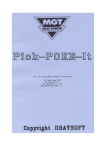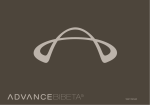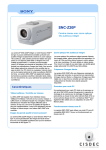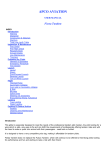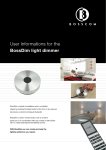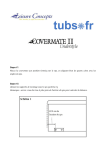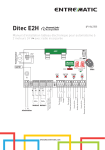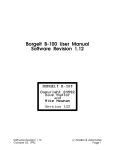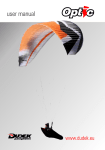Download ALPHA5
Transcript
ALPHA 5 User manual Edition 1 / 08_2011 Contents Thank you for flying ADVANCE ....................................................... 4 About ADVANCE .............................................................................. 5 The ALPHA 5..................................................................................... 6 Flying essentials............................................................................ 6 Other important details................................................................. 7 Pilot requirements............................................................................. 8 General advice about paragliding................................................ 8 Using the paraglider......................................................................... 9 Delivery......................................................................................... 9 Basic settings................................................................................ 9 Adjusting the brake lines............................................................... 9 Speed systems.............................................................................. 9 Suitable harnesses...................................................................... 10 Weight range............................................................................... 10 Flight characteristics...................................................................... 12 Takeoff......................................................................................... 12 Takeoff in light wind (forward takeoff)......................................... 12 Takeoff in stronger wind (reverse takeoff) .................................. 12 Normal flight ............................................................................... 13 Turning flight ............................................................................... 13 Accelerated flight........................................................................ 14.. Collapses .................................................................................... 15.. Rapid descents........................................................................... 16 Stalling......................................................................................... 18 Landing....................................................................................... 19.. Flying with a wet paraglider ....................................................... 19 Winching...................................................................................... 20 Paramotoring............................................................................... 20 Acrobatics................................................................................... 20 Maintenance, repairs and care ...................................................... 22 Packing ....................................................................................... 22 Care and maintenance ............................................................... 22.. Check ......................................................................................... 23 Repairs........................................................................................ 23 Disposal....................................................................................... 23 Technical details............................................................................. 24 Materials used............................................................................. 25 Certification................................................................................. 26 Service............................................................................................ 28 ADVANCE Service Center.......................................................... 28 The ADVANCE website............................................................... 28 Warranty...................................................................................... 28 List of parts..................................................................................... 30 Line plan ......................................................................................... 31 Risers ............................................................................................. 32 Bowline knots................................................................................. 33 3 Thank you for flying ADVANCE Congratulations on your choice of an ALPHA 5 - a quality product from ADVANCE. We are sure that you will spend many rewarding hours in the air with it. This user manual is an important part of the glider. Here you will find instructions and important information about safety, care of the glider and maintenance, and that’s why we recommend that you read this document carefully before your first flight. The latest version of this manual, as well as further updated information, can be found at www.advance.ch. Any new safety-related information will also be published on the website. If you have any further questions or problems please contact your dealer or get in touch directly with ADVANCE. We wish you a lot of enjoyment with your ALPHA 5, and always «happy landings». Team ADVANCE 4 About ADVANCE ADVANCE, based in Switzerland, is one of the world’s leading paraglider manufacturers. Since it was founded in 1988, the company has consistently pursued its own directions and concepts, both in development and production. The results are quality products with distinctive characteristics. ADVANCE attaches great importance to after-sales customer support, and has built up a worldwide service network for this purpose. An on-going interaction with its customers brings in a steady flow of new knowledge that finds its way into ADVANCE products, thus completing the «Circle of Service». At the heart of the ADVANCE brand is a team of specialists who share the passion of the customers who place their trust in the company’s products. With their thorough understanding of flying they contribute their valuable personal experience and dedication to the working processes. For many years ADVANCE has drawn on the competition scene for its technical expertise. Its small team of test and competition pilots regularly notches up remarkable sporting successes with ADVANCE prototypes, winning numerous important international titles. Total control of the production process and supervision of the working practices at the ADVANCE factory in Vietnam ensure a high standard of workmanship. Long term relationships with fabric and line manufacturers means that ADVANCE knowledge and expertise also finds its way directly into the development of new materials. 5 The ALPHA 5 ALPHA 5 – Flying essentials You want to live your dream of flying. As a beginner or leisure pilot you’d like a paraglider that you can trust 100%. The ALPHA 5 has this essential quality. It is the classic for first flights – and more! This 5th generation of the ALPHA line builds on more than 20 years’ experience of paraglider-making, and includes the latest technology. Outstanding features shape makes it very straightforward to deal with, keeping you feeling good from the moment you get into the air. All the essentials to best effect The ALPHA 5 doesn’t just make your first flights a lot of fun. A special design feature is internal diagonal ribs. Together with an optimised line plan this means noticeably better performance and the top speed in the A classification. With the ALPHA 5 you can make real headway in exploring the countryside. Lift-off made easy Light build, easy to take off. This simple formula means that your first ALPHA 5 pull-ups become an unforgettable experience. New Nylon wires hold the leading edge profile in perfect shape. Greatly reduced canopy weight and characteristic ADVANCE semi-circular air intakes make the ALPHA takeoff a simple affair. Simply flying safely Analytically designed crossports in the cell walls make a significant contribution to safety. They improve air transfer across the inside of the wing, so improving passive safety. The ALPHA 5’s compact 6 Other important details ADVANCE Standards EASY TAKEOFF SAFE FLIGHT ADVANCE pays a lot of attention to small details. Sewn-in tension straps improve the wing’s stability, and the distinctive winglets reduce induced drag (vortex-effect). The Smart Sail System aligns the material at the leading edge in the best direction to match the loads in this area, and a strong, specially impregnated fabric is used here to improve the life of the wing. Velcro closures at the wingtips make it easy to remove debris like sand and snow from the glider. Like all ADVANCE models the ALPHA 5 has swivels on the brake lines and different sized brake handles with magnets, depending on the glider size. FLYING ESSENTIALS 7 Pilot requirements Right from the start the ALPHA 5 gives the beginner or leisure pilot the safety they need when they lift off into the third dimension. A sense of achievement is guaranteed from the first flights, encouraged by the knowledge that you can always trust the ALPHA 5 completely. The ALPHA 5 is perfect for schools, but also provides improving pilots with continued flying enjoyment, with maximum passive safety, long after they have finished their training. General advice about paragliding Flying a paraglider calls for appropriate training and a sound knowledge of the subject, as well as, of course, the necessary insurance cover and licence. A pilot must be able to correctly assess the weather conditions before taking off. His or her capabilities must be adequate for the actual paraglider. Wearing an adequate helmet, suitable boots and clothing, and carrying an emergency parachute are essential. Before every flight all items of equipment should be checked for damage and airworthiness. A proper pre-takeoff check must also be carried out. Every pilot bears sole responsibility for his or her participation in the sport of paragliding. Neither the manufacturer nor the seller of a paraglider can guarantee or be held responsible for the pilot’s safety. 8 Using the paraglider Delivery Adjusting the brake lines Before delivery every ADVANCE paraglider has to be flown by the dealer and checked for correct settings and trim. When this has been done the dealer enters the date of the first flight on the label attached to a centre rib. This entry, together with a completed warranty card returned to ADVANCE, will ensure that defects in the product attributable to manufacturing faults are covered by the ADVANCE warranty. See Warranty in the section «Service». The length of the brake lines is set at the factory so that the trailing edge is not braked (is crease-free) when brakes are fully released in fully accelerated flight. This setting should be kept as a matter of principle. The ALPHA 5 comes with a backpack, an inner bag, a compression strap, a repair kit, speed bar with lines, a mini windsock in the canopy colours and a user manual with a warranty card and service booklet. If the length of the brake lines has to be readjusted there must be 8cm of slack (free travel) between the brakes free position and the first influence of brake effect in unaccelerated flight (brake starts to take effect). We recommend that the brake handles are secured with a bowline knot. Look at the illustration at the end of this manual. Speed system Basic settings The basic ALPHA 5 set-up at delivery is the original trim setting that the ADVANCE test team have found to be best; and the glider was certified in this condition. Any personal alterations or modifications to the paraglider - for example, changing the line lengths or fitting different risers or quick links by the owner - will result in invalidation of the certification. See section «Certification». The ALPHA 5 has a speed system, which can increase the speed by up to 10 km/h above trim speed. When operated the speed system shortens the front risers, so reducing the wing’s angle of attack. The ALPHA 5 speed system is designed to fully retain the wing profile during accelerated flight, keeping the wing’s good qualities at high speed. Adjust the speed system correctly before your first ALPHA 5 flight. Make sure that the speed lines run freely through all the pulleys in 9 your harness. Connect the speed lines to the glider risers using Brummel hooks. Finally check that your settings allow you to use the full travel of the speed system. To do this it is best to hang the harness up, sit in it, connect the risers and have someone else hold them up as if in flight. Caution: The speed system is correctly adjusted when you can use the full travel available on the wing. Make certain that the speed lines are not set too short, thus causing the wing to be pre-accelerated all the time. Suitable harnesses The ADVANCE ALPHA 5 is certified for harnesses in Group GH (without rigid cross-bracing – see section «Certification»). The suspension points of the chosen harness should ideally have a carabiner distance of approximately 45 cm (just about equivalent to your shoulder width) and a height of 40 to 48 cm. The ALPHA 5 is neither suitable nor certified for use with harnesses in group GX (with effective cross-bracing). The use of such harnesses can have a bad effect on both handling and extreme flight characteristics. Info: Experience has proved the theory – a streamlined har- ness can significantly improve gliding performance. Weight range The weight ranges of the different sizes are given in the section «Technical data». The figures given there represent the total in-flight weights. This includes the pilot’s body weight, plus clothes, as well as the weight of all the equipment (glider, reserve, harness, instruments etc.). Flying at the lower or upper weight limits can have an effect on the paraglider’s flying characteristics and handling, but without influencing the pilot’s safety. Glide performance remains the same over the whole weight range, but climbing performance will be altered. When the ALPHA 5 is flown in its upper weight area, the higher wing loading produces a higher trim speed, and a more dynamic and agile flying character. Remark: The ALPHA 5 has a weight range that has been extended above the recommended region, but still keeps its EN/LTF A certification; the EN/LTF A approval includes a weight increase of around 15 kg above the recommended weight ranges for the 23, 26 and 28 sizes. When the ALPHA 5 is flown in its upper weight region, the higher 10 wingloading produces a higher trim speed, and a more dynamic and agile flying character. The fact that the ALPHA 5 keeps its EN/LTF A rating at the higher wing loadings confirms its high degree of passive safety. 60 70 ALPHA 5/23 80 55 - 80 kg 90 100 110 120 130 + 15 kg ALPHA 5/26 70 - 95 kg ALPHA 5/28 + 15 kg 85 - 110 kg + 15 kg ALPHA 5/31 100 - 130 kg Plage de poids conseillée à vitesse trimée selon la charge emportée Plage de poids étendue à vitesse trimée selon la charge emportée Côté dynamique : maniement plus direct et vitesse/sol plus élevée Recommended weight range with trim speed as a function of load Côté thermique : meilleure ascension par conditions faibles et comportement en vol amorti Increased weight range with trim speed as a function of load (perfect for acro beginners) Dynamic side: More direct handling and higher groundspeed Thermaling side: Better climbing in weak conditions, and a more damped flying behaviour 11 Flight characteristics We recommend that you make your first flights with your new glider in quiet conditions, in a familiar flying area. A few pull-ups at an easy site will give you confidence in the ALPHA 5’s handling qualities, from the very beginning. until all the A lines are equally tensioned. This will produce the best curve. Info: You can pull up the ALPHA 5 with all A-risers if you wish, but taking off with inner A-risers only has definite advantages. Takeoff Takeoff in light wind (forward takeoff) Before every takeoff carry out the following pre-takeoff checks: 1.Harness and helmet done up, reserve OK? 2.Lines free? 3.Canopy open? 4.Wind direction and strength assessed? 5.Airspace and field-of-view clear? The ALPHA 5 takeoff behaviour is very smooth and easy for both forward and reverse takeoffs. The canopy inflates quickly and rises progressively, without hanging or shooting in front. The ALPHA 5 only needs a moderate pull-up impulse even in a light wind. It is not necessary to step back and ‘run’ into the lines. Guide the glider up with pronounced leaning forward, but without too much of a pull on the inner A-risers, until the canopy is overhead. During the pull-up phase any correcting should only be done by decisive going-under-the-wing, without using the brakes. After any necessary correcting and a satisfactory visual check a few determined steps with good leaning forward will achieve lift off, even in little wind. Takeoff in stronger wind (reverse takeoff) The ALPHA 5 has split A-risers, and we recommend the use of the inner A-risers for takeoff. The wing will fill reliably from the middle out, and will pull up straight with little effort. Tip: To get the wing in the right shape for takeoff do the fol- lowing: pull the brake lines in while you are sorting the lines The reverse takeoff is mainly recommended for stronger winds. Like the forward takeoff we recommend that you use the ALPHA 5 inner A-risers. During the pull-up you should walk towards the ALPHA 5 as necessary. Turning round and taking off with the ALPHA 5 will then prove to be easy. 12 Tip: Playing with the glider on flat ground in some wind gives a good feeling for the wing. You can get to know the ALPHA 5’s characteristics very well, and try out takeoffs, stalling, shoot- ing forward tendency and collapses – while remaining safely on the ground. The ADVANCE test team have a motto: one hour ground training is worth 10 high flights. N.B: Ground handling practice can increase wear on your glider. Normal flight In calm air the ALPHA 5 best glide is achieved with fully released brakes. Light braking brings the glider to its minimum sink condition. When flying into a headwind, through descending air, or when proceeding to the next thermal, glide performance will be distinctly improved by appropriate use of the speed system. • When the angle of attack reduces (glider dives forwards, pilot swings back) the wing should briefly be braked more. Be careful not to get below minimum speed, and don’t overreact with the brakes. Turning flight The ALPHA 5 has precise response to brake application. It reacts directly and progressively to increasing steering demands, once the brake line free travel has been taken up. Steering can be effectively assisted by active weight shift. Angle of bank can always be increased, stabilised or reduced by the appropriate pull on the brake line. Despite the wing’s high stability an active flying style is recommended – collapses can be almost completely avoided. This means keeping the lightly-braked glider directly above you, in other words, countering roll and pitch disturbances. When circling in a thermal choose the desired angle of bank and corresponding turn radius by using the inside brake line, and let the paraglider turn steadily like this. Stabilise the outside wing with outside brake as required and, in particular, keep a check on the rate of turn. Too much brake on the outside wing will slow the turn and the airspeed down, and lose the glider’s good steering qualities. • When the angle of attack increases (wing goes into a thermal; wing swings back) the brake lines should be temporarily released fully, until the glider returns to its overhead position. A harness that is matched to the ALPHA 5 flying qualities helps you enter and settle on a very steady turn. See also section «Suitable harnesses». 13 Caution: To keep good manoeuvrability make sure to fly your ALPHA 5 with enough airspeed while turning in thermals – not too much outside brake. Tip: If a brake line were to break you can steer your ALPHA 5 with the rear D-risers if necessary. and good gliding performance attained. See also section “Adjusting the Speed system“. • If the angle of attack increases (e.g. wing goes back in rising air) the speedbar should be briefly but strongly pushed. • If the angle of attack reduces (e.g. wing shoots forward) the speed bar should be released. Accelerated flight The ALPHA 5 wing remains extremely stable even in accelerated flight. However, paragliders operate at a lower angle of attack while flying at their higher speeds, and the degree of stability is generally reduced. The higher aerodynamic forces involved at higher airspeeds mean that a collapse can be more dynamic. See also section «Collapses». When encountering strong turbulence while flying accelerated you should first release the speedbar completely before applying the brake necessary to stabilise the wing. The high stability of the ALPHA 5 allows light turbulence to be flown through while accelerated. While doing this active accelerating should be used, whereby the angle of attack is accommodated by using the speedbar instead of the brakes. In this way pitch disturbances will be reduced to a minimum, Caution: Even though the ALPHA 5 is stable in accelerated flight you should only use as much speedbar as you feel hap- py with. Tip: Make sure that you do not use speedbar and brake at the same time, otherwise you will get into the worst possible gliding situation, to no advantage. Tip: For best gliding always choose a speed that takes into account actual headwind, sink rate and expected next climb. 14 Collapses open side, and only apply enough to keep straight – so as not to stall the wing. Asymmetric collapse of the wing The ALPHA 5 has a very stiff and stable canopy. With an active flying technique collapses can be almost completely prevented in normal flying conditions. If the glider does, however, suffer a side collapse at trim speed, it will respond to collapses of 50% or more with a slight to moderate turning tendency (modest turning to the side), allowing heading to be easily held with light counter-steering. Normally, the wing will reopen without pilot action. Due to higher aerodynamic forces during accelerated flight the glider will respond to a side collapse more impulsively. The turning tendency in fully accelerated flight will be more dynamic, but is still well controllable. Turning away is unspectacular and slow, even after a collapse at full speed. If a collapse is slow to reopen, a deep but fast pull on the closed side brake will help. It is important to completely release the brake again to let the glider keep its flying speed. Be careful with the brake on the Poorly flown wingovers can cause a wingtip to fold inwards from the side, causing it to catch in the lines and create a cravat. Due to the high drag they produce cravats can lead to strong rotation (spiralling). Stop an increase in rotation rate by just the correct amount of outside brake. Then open the cravated wingtip by pulling the orange stabilo line. Clearing a cravat can be also done more quickly by ‘pumping’. The appropriate brake should be applied to 75% brake travel within a maximum of two seconds, and then released immediately. Symmetric collapse (frontstall) After a spontaneous or A-riser provoked collapse the airflow breaks away from the profile and the canopy will pitch back. The pilot swings back underneath after a short delay. Wait, without applying brake, until the wing is again above you and returns to normal flight. After a big collapse reopening may be delayed, but do not forceably encourage reopening by the use of excessive brake, because of the risk of a fullstall. 15 Rapid descents For quick and efficient ways of getting down the ADVANCE test team recommend big ears (with or without speed bar) or the spiral dive – the choice depends on the situation. Tip: Fast descents should be practised now and then in quiet conditions – so they won’t become emergencies when you need them. Symmetrical collapsing of the wingtips (big ears) The ALPHA 5 has split A-risers, which make applying big ears easy. To do this pull both outer, red-marked A-lines briskly down at the same time. This will fold the wingtips in, and you can hold them there easily. To reopen release the A-lines; the ALPHA 5 wingtips then open themselves thanks to the high internal wing pressure. Sink rate can be further increased by using the speedbar. Depending on the situation the glider can be steered using weight shift. Remark: Big ears is also possible using two lines (per side) with the ALPHA 5. Here it is important that the glider must be accelerated as well, and the trailing edge must not be braked. Caution: Do not fly spirals or sharp changes of direction with big ears applied; the increased loading carried by fewer lines can damage the structure. Caution: Be aware that flying with big ears brings the stall closer. Be careful with the brake lines when big ears are ap- plied, and do not use this descent method if the wing is wet. See also section «Flying with a wet paraglider». Tip: If you want to lose height as quickly as possible and fly away from a danger zone at the same time we recommend the following: apply big ears and use as much speedbar as conditions allow. Spiral dive For the most comfortable way of doing this we recommend a neutral sitting position without active weight shift, and a shoulder-width carabiner distance (approx 45 cm). Enter the spiral by progressively pulling one brake. Your head and field of view should be directed in the turn direction. As the angle of bank increases so will the rate of turn and centrifugal force. 16 The behaviour of the spiralling paraglider can be separated into two phases: in the beginning the glider begins with a normal turn which progressively tightens, with increasing angle of bank. In the second phase the paraglider engages its spiral mode. This means that the wing dives forward with an increase of acceleration. During this phase of the manoeuvre try to keep a neutral sitting position and give way to the centrifugal force – your body will be pushed to the outside. Caution: The ALPHA 5 was tested in accordance with the lat- est certification requirements. In a neutral sitting position, and after releasing the inside brake, a spiral dive of up to 14 m/s sink rate recovers by itself. Spirals of higher sink rates can remain in a stable turn if weight shift is applied to the in side of the turn. Weight shift to the outside or pulling outside brake is sufficient to recover from a high sink rate spiral. Recovery from the manoeuvre is achieved by progressively releasing the inside brake. While coming out of a spiral dive with high vertical and rotational speeds it is essential to release the brake carefully, and/or reapply a little inside brake if necessary, so that you can prevent the wing pitching back excessively, and then diving in front. Make sure that you start the recovery with plenty of height remaining above the ground. Generally speaking you should allow the same amount of time to recover as it took to enter the manoeuvre, but remember that the sink rate will be higher! Caution: The ALPHA 5 is certified for harnesses in group GH (without rigid cross-bracing). Group GX harnesses (with cross-bracing) or those with very low hang points could dras- tically alter the flying behaviour in the spiral dive. See section «Suitable harnesses». Caution: Do not fly spiral dives or aggressive changes of di- rection with big ears applied: the raised wing loading carried by fewer lines can damage the glider. The ALPHA 5 comes out of a steep spiral dive by itself if a neutral sitting position is maintained. Active weight shift to the inside of the turn can lead to stronger acceleration and the glider may show less desire to recover by itself. B-stall The whole paraglider structure and its profile shape would be severely strained by a B-stall. We recommend that you don’t fly B-stalls on a regular basis. This manoeuvre does not present special difficulties. It is difficult for light pilots to do because of the high force required. 17 Stalling Fullstall One-sided stall (spin) ALPHA 5 brake effect and resistance starts early, but the brake travel is very long. This gives the pilot a high safety margin. When circling tightly in a thermal the ALPHA 5 indicates early and clearly, by strongly increasing brake load, the risk of a stall. Even so, if a wing does stall you will feel a marked reduction of brake load on the inside of the turn. If this happens you must immediately release the brake lines, so that the ALPHA 5 can return to normal flight by itself. If a wing stalls completely the paraglider will go into a spin / negative rotation. The ALPHA 5 will react dynamically, but will still be manageable by the less experienced pilot. Even so – depending on the situation from which the paraglider is allowed to fly again – the reaction can be quite vigorous (shooting forward with a raised risk of collapse). The canopy can be arrested while shooting forward by welljudged braking. Normal flight can then be resumed without a further collapse. Tip: Basically, in all out-of-control flight situations, but espe- cially the onset of a one-sided stall, you should immediately release both brakes fully – hands up! Entry into a fullstall is achieved by progressively and symmetrically pulling down both brake lines. Forward speed reduces. Airflow and wind noise reduce. After reaching minimum speed the paraglider first goes into a brief phase of parachutal stall. Then further brake will cause complete airflow breakaway, and the wing will fall back in fullstall. The ALPHA 5 has a strong desire to fly again, but is easy to hold in the stall. Under some conditions a brake wrap makes sense when flying a fullstall. To recover, the canopy has to be pre-inflated. To do this the brakes should, at first, be released slowly and symmetrically, and only fully released when pre-inflation is complete. The ALPHA 5 then flies away relatively cleanly, without shooting forward too much. Tip: Basically, in all out-of-control flight situations, you should immediately release both brakes fully – hands up! 18 Deep stall Stable parachutal stall cannot be established, whether attempted by brake or B-stall. In rain, or if the canopy is wet, the ALPHA 5, like all paragliders, is more vulnerable to parachutal stall. If the wet glider were to go into parachutal stall you should recover only by accelerating using the speedbar. See also section “Flying with a wet paraglider“. Landing Always make a proper landing circuit with a well-planned final approach. As the ground approaches progressively increase brake to level the flight-path, before applying full brake to completely arrest the forward speed. Caution: Steep turn reversals lead to strong swinging of the pilot, and should not be done near the ground. Caution: Braking will reduce your speed and increase your sink, but it will certainly seriously restrict your ability to ma- noeuvre. Caution: Getting below minimum speed leads to stalling: this should unquestionably be avoided when top landing, and on final approach. Caution: Never let your glider fall to the ground on its leading edge. The overpressure so caused inside the wing can rip the cell walls and damage the leading edge. Flying with a wet paraglider Flying with a wet glider creates a risk of deep stall. Deep stall is often the result of a combination of factors. The weight of the wet canopy goes up, and this increased weight increases the angle of attack, which always puts the glider nearer the deep stall limit. Added to this, water drops on the top surface have a detrimental effect on the laminar flow of the boundary layer near the leading edge, which distinctly reduces the maximum lift coefficient. If the wet glider is also being flown at its lower weight limit there is a further small effect of increasing the angle of attack, as well as there being a lower airspeed because of the reduced wing loading. In order to avoid the risk of deep stall with a wet glider the wing should be braked as little as possible, and big ears not used at all. As a further preventative measure apply moderate (25-40%) speed bar. 19 All these actions have a small effect in reducing the angle of attack. Acrobatics Should the wet glider get into deep stall, recovery can only be achieved using the speed bar. See also section «Deep stall». While developing the ALPHA 5 attention was concentrated on simplicity, safety and user-friendliness – both in general use and flying behaviour. Winching The ALPHA 5 is suitable for winch launching. When taking off in windless conditions, ensure that the paraglider is laid out in an arched or even wedge shape (to avoid risk of the glider rosetting): Winch launch is only permitted if: • the pilot has completed a tow training course (only Germany/ DHV); • the winch system is certified for use with paragliders; • the winch operator has been fully trained in how to winch paragliders. Assuming adequate pilot ability and correct technique, the ALPHA 5 lends itself well to flying such manoeuvres as the wingover, SAT, helicopter and asymmetric spiral. The wing was tested to the usual 8g load factor, but is not specially strengthened. Be aware that dynamic manoeuvres put greater loading on the structure and can shorten the glider’s life. This means that a regular check of the paraglider is essential for your safety. In addition there will be the special requirements of your country to be observed. Paramotoring The ALPHA 5 can alos be used with an engine. You can find the information about paramotoring with the ALPHA 5 on www.advance.ch. 20 21 Maintenance, repairs and care Packing Pack your ALPHA 5 nose wire on nose wire, so that the plastic rods in the ribs at the leading edge lie as flat as possible on one another, all at the same height. This will prolong your ALPHA 5’s life and keep its fast and excellent filling qualities at takeoff. You should randomly offset your packing centreline so that the final chordwise fold is not always along same cell. Only pack and store a dry paraglider, and avoid unnecessary compressing and tight packing. Care and maintenance Ultraviolet light, heat, humidity, sea water, aggressive cleaning agents, unsuitable storing and physical abuse (dragging across the ground) speed up the ageing process. The life of a paraglider can be extended significantly by observing the following advice: • Let a wet or damp glider dry by leaving it completely unpacked at room temperature, or outside in the shade. • If the glider gets wet with salt (sea) water rinse it thoroughly with fresh water. • Clean the glider only with fresh water, and a little neutral soap if necessary. Do not use solvents under any circumstances. • If the glider has been subjected to increased stress (such as a tree landing) have it examined by an expert. • Regularly remove sand, leaves, stones and snow from the cells. Openings with Velcro closures are provided at the wing tips for this purpose. • Do not leave the glider out in the sun unnecessarily before and after flight (UV light). • Do not subject the packed glider to excessive temperature fluctua- tions, and do ensure adequate air circulation to prevent condensa- tion forming. • Do not drag the glider across the ground. • When landing, make sure that the canopy does not fall on its lead- ing edge. What to do if the leading edge gets damaged? If a plastic rod breaks or its seam rips the glider must be taken to an ADVANCE checking facility where the rod can be replaced or sewn back in. To guarantee a long lifespan it is important that the wing is not allowed to fall on its leading edge after landing, otherwise the fabric can be damaged by abrasion. But mainly there is a risk, as in all paragliders, that the crossports could tear. 22 Check Disposal A new ADVANCE paraglider must be given a check every 24 months (2 years). With intensive use (> 150 flying hours per year, or excessively demanding use) an annual check is needed, after the first check. When a check is carried out the condition of all materials is assessed in accordance with strict guidelines, and tested with great care. Finally the overall condition of the glider is rated and recorded in a test report. You can find additional information about the check in this manual in the section «Service», or at www.advance.ch. Environmental protection plays an important role in the selection of materials and the manufacture of an ADVANCE product. We use only non-toxic materials that are subjected to continuous quality and environmental impact assessments. When your paraglider reaches the end of its useful life in a number of years’ time, please remove all metal parts and dispose of the lines, canopy and risers in a waste incineration plant. Repairs As a general rule you should not attempt to repair a paraglider yourself. The various seams and lines are made with great precision, and, for this reason, only the manufacturer or an authorised service centre may fit identical replacement parts or replace entire cells. Exceptions to this rule are the replacement of lines and the repair of small tears (up to 5 cm) or holes in the fabric that may be glued with the self-adhesive ripstop included in the repair kit. After a repair, or the replacement of a line, the glider must always be opened out and checked on the ground before the next flight. 23 Technical details ALPHA 5 Flat surface Projected surface Recommended take off weight 2 Increased weight range 2 Glider weight Aspect ratio Trim speed 1 Max. speed 1 Min. sink rate 1 Best glide 1 Span Projected span Projected aspect ratio Max chord Min chord Number of cells Number of risers Riser length Max length of the lines with the risers Min. speed 1 Paramotor certification LTF 23-05 Certification 1 m m2 kg kg kg 2 23 26 28 31 23.75 20.40 55-80 80-95 4.7 25.97 22.30 70-95 95-110 5.0 28.48 24.46 85-110 110-125 5.5 31.81 27.32 100-130 6.0 11.77 9.38 12.44 9.92 3.02 0.68 3.19 0.720 48 746.0 50 788.7 87-137 112-137 4.85 38 +/- 1 47 +/- 2 1.15 8.4 +/- 0.1 km/h km/h m/s m m 10.75 8.75 11.24 8.96 m m 2.76 0.62 2.88 0.65 3.60 39 4+1 cm cm km/h 44 681.5 46 713.0 - 87-137 22 +/- 1 Values depend on wing loading, harness/pilot and glider size within the recommended take off weight ranges EN / LTF A 2 Pilot, wing, equipment 24 Materials used We routinely inspect and test our materials many times over. Like all ADVANCE products the ALPHA 5 is designed and produced as a result of the latest developments and knowledge. We have chosen all the materials very carefully, under conditions of the strictest quality control. Leading edge New Skytex 6.6, Evolution water-repellent, 9092 E117, 44 g/m2 Top surface New Skytex 6.6, 9017 E77A, 40 g/m2 Bottom surface DOMENICO DOKDO-20MF, 34 g/m2 Supported ribs New Skytex 6.6 hard, 9017 E29, 40 g/m2 Unsupported ribs New Skytex 6.6 hard, 70000 E91, 27 g/m2 Enclosing strap of the leading edge and trailing edge Polyester laminiert 20 mm Enclosing strap of the leading edge lower surface Polyamid 16 mm Suspension lines • Edelrid Technora (Aramid) 6843, 240/200/160, sheated, 2.1 mm / 1.9 mm / 1.5 mm (main lines) • Edelrid Technora (Aramid), 6843, 120, sheated, 1.4 mm (2nd level) • Liros Dynema, DSL 70, sheated, 0.95 mm (1st level) • Liros Dynema, DSL 70 / DFL 115, sheated, 0.95 / 1.3 mm (brake lines) • Liros Dynema, DFL 115, sheated, 1.3 mm (stearing line up) • DFLP 200, Dyneema/Polyester, sheated, 1,9 mm (stearing line low) Risers Polyester 22 mm – 1100 kg Quick links Maillon Rapide, Inox rostfrei, 3.5 mm – 750 kg Stitching thread Polyester 25 Certification The ALPHA 5 has EN and LTF certification. The test reports can be downloaded from www.advance.ch. Certification ratings can only provide limited information about a paraglider’s flying behaviour in thermally active and turbulent air. The certification grading is based primarily on provoked extreme flight manoeuvres in calm air. During the development of an ADVANCE paraglider, the emphasis is first and foremost on flying behaviour and handling, and not exclusively on the certification test. The result is a well-rounded product with the familiar ADVANCE handling. Nevertheless, the certification rating occupies a significant proportion of the specifications that have to be met. 26 27 Service ADVANCE Service Centres ADVANCE operates two company-owned service centres that carry out checks and repairs of all types. The workshops based in Switzerland and France are official maintenance operations, certified by the German Hanggliding and Paragliding Federation (DHV), which has many years’ experience and in-depth product-specific expertise. The ADVANCE worldwide service network includes other authorised service centres that provide the same services. All service facilities use original ADVANCE materials exclusively. You can find all information on checks and repairs and the relevant addresses at www.advance.ch. The ADVANCE website At www.advance.ch you will find detailed information about ADVANCE and its products, as well as useful addresses which you can contact if you have any questions. Among the things you will be able to do on the website are: • complete the warranty card online up to 10 days after purchasing the glider, enabling you to enjoy the full benefits of the ADVANCE warranty. • find out about new safety-related knowledge and advice con cerning ADVANCE products. • download an application form in PDF format which you can use when sending your glider in for a check at ADVANCE. • find an answer to a burning question among the FAQs (Frequently Asked Questions). • subscribe to the ADVANCE Newsletter so that you will be regularly informed by e-mail about news and products. It is well worth visiting the ADVANCE website regularly because the range of services offered is continuously being expanded. Warranty In order to enjoy the full benefits of the ADVANCE warranty, you are requested to complete the relevant form on the website in the «Warranty» section within 10 days of purchase. As part of the ADVANCE warranty, we undertake to rectify any defects in our products that are attributable to manufacturing faults. In order for a warranty claim to be made, ADVANCE must be notified immediately on discovery of a defect and the defective product sent in for inspection. The manufacturer will then decide how a possible manufacturing fault is to be rectified (repair, replacement of parts or replacement of the product). This warranty is valid for three years from the date of purchase of the product. 28 The ADVANCE warranty does not cover any claim other than those listed above. Claims in respect of damage resulting from careless or incorrect use of the product (e.g. inadequate maintenance, unsuitable storage, overloading, exposure to extreme temperatures, etc.) are expressly excluded. The same applies to damage attributable to an accident or normal wear and tear. 29 List of parts Nylon Wires Zellen Zugbänder Ring-Raff-System Winglet Klettöffnung 30 Line plan 23 / 26 / 28 / 31 ALPHA5 23 / 26 / 28 / 31 ALPHA5 A1 A2 A3 A4 A1 2A1 A5 A2 A3 A6 A4 A7 A5 2A2 2A1 A6 A8 2A2 A7 A8 2A3 2A4 B1 B2 B3 3A1 2B1 B1 B2 B5 B3 B4 B6 3A1 2B2 2B1 B7 C2 C3 C1C4 C5 2C1 2C2 D2 D3 D2 D4 D5 3C1 3C1 2D1 3A2 C5 C6 2D1 C6 D3 2C4 D6 2D3 2D2 2D4 C9 2C6 2D5 D10 B12 A13 2B6 2C5 C12 D9 C11 3B3 D10 D12 D11 C12 2C6 B13 2D5 3CD3 C13 13 i10 9 VR1 F2 SL low VR1 SL low VR2 SL up F5 F4 F3 F4 F3 SL up VR3 St D C St VR2 13 o 13 i 11 13 o 12 F6 8 F2 F1 F1 F5 9 7 6 12 10 7 6 5 4 5 4 3 2 11 8 3 St C St C St D 3D2 2 St A St B St B D12 D11 C St 1 B13 C13 St A 2D6 3D2 3D1 A13 C10 2D4 3D1 1 A12 B11 B12 2D6 3CD3 A11 2A6 3A3 2B5 C11 3B3 D8 D9 3C2 2D3 2A5 A12 B10 B11 2B6 D7 D8 D7 3C2 B9 C10 2C4 2C5 D5 D4 D6 2D2 3A3 2B5 C8 C7 2C3 2A6 B10 C9 3B2 3B2 A11 B8 B9 2B4 C8 C7 2C2 2A5 B7 2B3 C4 2C3 D1 D1 B8 2B4 3B1 3B1 2C1 C3 A10 B6 3A2 2B2 C2 B5 A9 A10 2A4 B4 2B3 C1 A9 2A3 VR3 F6 geschnitten: ...................... kontrolliert: ...................... geschnitten: ...................... kontrolliert: ...................... Gesamtleinenlänge in m : Gesamtleinenlänge in m : .......... .......... 31 Risers 1 Leinenschlösser und -clips 2 Umlenkrollen Beschleuniger 3 Brummelhaken 4 Magnetclips 5 Wirbel 6 Speed-Performance-Indicator (SPI) 7 SPI-Skala (Rückseite C-Tragegurt) 4 1 2 5 3 4 32 Bowline knots Schritt 1 Schritt 2 Schritt 3 Schritt 4 Schritt 5 33 34 35 advance thun ag u t t i g e n g s t r a s s e 87 ch 3600 thun f o n + 41 3 3 225 70 10 f a x + 41 3 3 225 70 11 w w w. a d v a n c e.c h i n f o @ a d v a n c e.c h




































